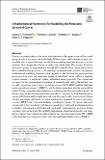A mathematical framework for modelling the metastatic spread of cancer
Abstract
Cancer is a complex disease that starts with mutations of key genes in one cell or a small group of cells at a primary site in the body. If these cancer cells continue to grow successfully and, at some later stage, invade the surrounding tissue and acquire a vascular network, they can spread to distant secondary sites in the body. This process, known as metastatic spread, is responsible for around 90% of deaths from cancer and is one of the so-called hallmarks of cancer. To shed light on the metastatic process, we present a mathematical modelling framework that captures for the first time the interconnected processes of invasion and metastatic spread of individual cancer cells in a spatially explicit manner—a multigrid, hybrid, individual-based approach. This framework accounts for the spatiotemporal evolution of mesenchymal- and epithelial-like cancer cells, membrane-type-1 matrix metalloproteinase (MT1-MMP) and the diffusible matrix metalloproteinase-2 (MMP-2), and for their interactions with the extracellular matrix. Using computational simulations, we demonstrate that our model captures all the key steps of the invasion-metastasis cascade, i.e. invasion by both heterogeneous cancer cell clusters and by single mesenchymal-like cancer cells; intravasation of these clusters and single cells both via active mechanisms mediated by matrix-degrading enzymes (MDEs) and via passive shedding; circulation of cancer cell clusters and single cancer cells in the vasculature with the associated risk of cell death and disaggregation of clusters; extravasation of clusters and single cells; and metastatic growth at distant secondary sites in the body. By faithfully reproducing experimental results, our simulations support the evidence-based hypothesis that the membrane-bound MT1-MMP is the main driver of invasive spread rather than diffusible MDEs such as MMP-2.
Citation
Franssen , L C , Lorenzi , T , Burgess , A & Chaplain , M A J 2019 , ' A mathematical framework for modelling the metastatic spread of cancer ' , Bulletin of Mathematical Biology , vol. 81 , no. 6 , pp. 1965-2010 . https://doi.org/10.1007/s11538-019-00597-x
Publication
Bulletin of Mathematical Biology
Status
Peer reviewed
ISSN
0092-8240Type
Journal article
Collections
Items in the St Andrews Research Repository are protected by copyright, with all rights reserved, unless otherwise indicated.

